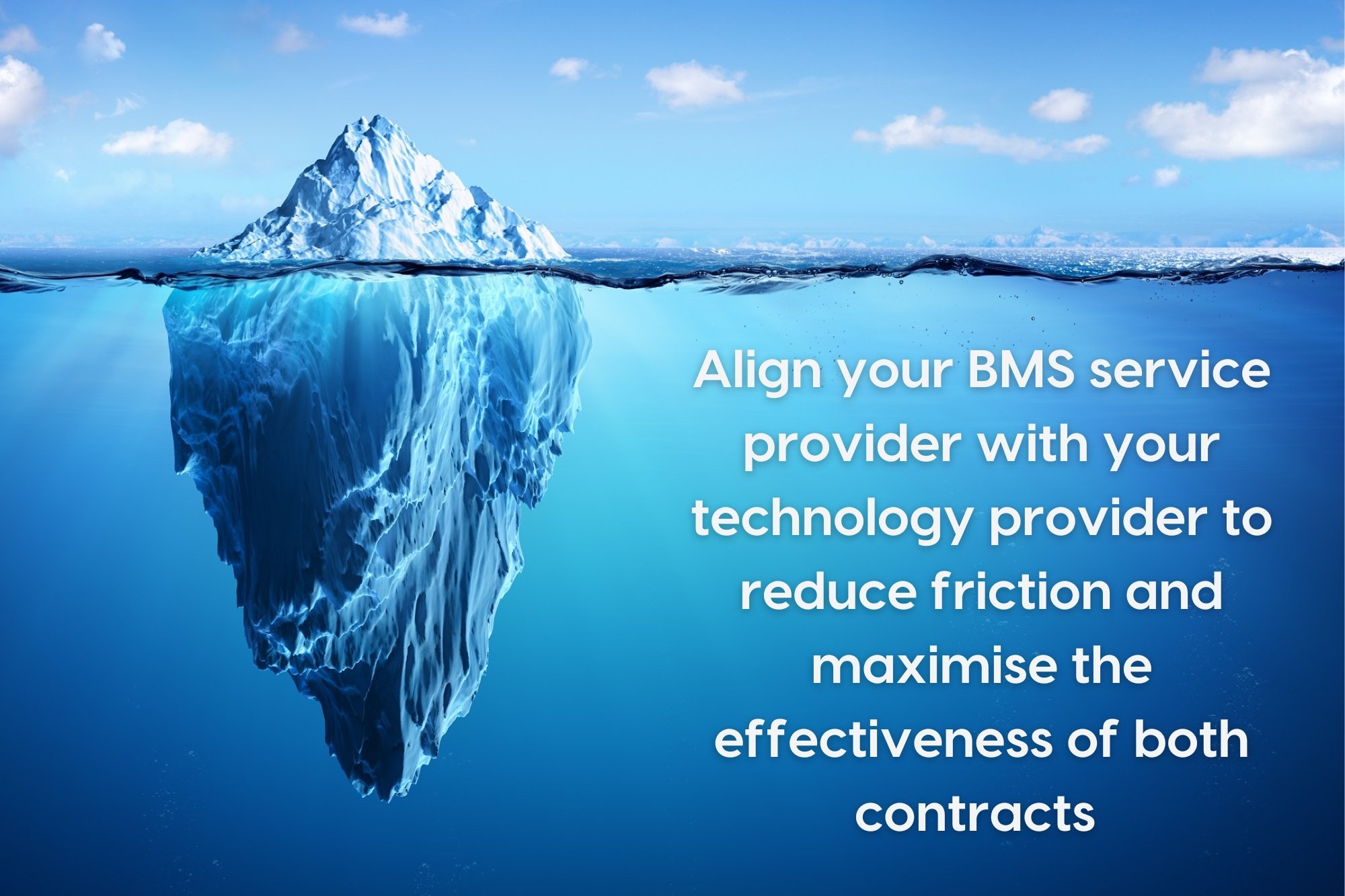
COURSES
BMS Maintenance Specification + Course
Learn how to issue a BMS maintenance specification and align the BMS contractor with the technology provider, and get high-value BMS activities included as part of normal maintenance rather than offered as chargeable extras.
BMS maintenance specification + course
Over the years, I have delivered three different types of BMS training courses to facility managers. And I have realised when doing them, FMs have a lot on their plate and don’t actually need to know the details. But they do need to know how to solve very specific problems. This is a unique course because it focuses on one thing, how to restructure a BMS maintenance contract so that BMS companies are aligned with technology providers and high-value activities are provided as part of normal maintenance and not offered as optional paid-for extras.
I.e., improving your building’s energy efficiency rating, reducing utility bills, continual year-on-year improvements to the BMS, future-proofing, and financial forecasting are built into normal maintenance and not considered chargeable extras. The maintenance specification completely changes what BMS service technicians do when they attend site so that high-value activities don’t cost extra.
Each specification clause solves a specific problem, and because I explain each clause (5 hours of video lessons), you will learn why we have these issues, how they happened, and how we can correct them.
There are four reasons to purchase the specification and course.
If you intend to purchase or have purchased a cloud technology product, then you must align the BMS company with the technology solution. The effectiveness of the technology product will be limited if the BMS company is not actively collaborating with the technology product. Unfortunately, this proactive collaboration does not happen on its own. You need to facilitate the collaboration with a contractual document (specification).
You want high-value activities built into normal maintenance without doubling the BMS maintenance contract value. To do this, you need to completely restructure what the BMS service technicians do when they attend site.
You want transparency in BMS maintenance pricing.
You want the BMS contractor to be accountable to your scope of work and not their fee proposal.
Note: You do not need a technology application or analytics to implement the specification.
Disclaimer: you can not restructure a BMS maintenance contract to get high-value activities for free if the BMS service technician only attends site one day per quarter. You can not optimise one day per quarter. You need a large enough existing maintenance contract to get optimisation and enhancements built in for free.
Who is this course for?
Every commercial building needs to modernise its BMS maintenance contract, especially large, premium, critical facilities.
Building owners, building engineers and facility managers can modernise their existing BMS maintenance contract.
Everyone else can generate a revenue stream from this specification + course.
Facility managers, building owners and building engineers (modernise)
This is a DIY BMS maintenance specification. You do not need to engage a consultant.
Option 1: you get the building owner to purchase the specification + course and you execute it just like you would anything else.
Option 2: You monetise it (FM agencies). All the FMs do the course and execute it on all their sites. You put in a fee to the building owner for the specification and your time.
Consultants (revenue)
This was a revenue stream for me. There is no reason it couldn’t be for you. Do the course, get the specification, and rebrand it as your own product. Modify it, add to it, remove from it, and make it your own. I am serious, if I went all in on this, it could be my primary product. After about 40 buildings, I just got a little bored of it.
BMS companies (modernise + revenue)
This specification + course was not created for BMS companies. In fact, you may not like some of the truths that get told. And you may not like how it shuts down some of the bad behaviour in our industry (sorry I said that). But, if you want to get ahead of this before it gets pushed down onto you, you could do the course and then reverse engineer the specification into your own BMS maintenance process.
Do not do this course if you don’t have an open mind.
Do not do this course if you are not open to change.
And, please do not moan at me. It wasn’t specifically created for you, but you can use it to differentiate from your competitors.
Do the right thing by your customer, and the money will flow.
I was about to tell you how much I charge for this, but I don’t want to limit your potential earning. $5k, $10k, $20k per building? I have saved building owners hundreds of thousands of dollars per year, every year, forever, with this specification!
What are high-value activities?
Typical BMS Periodic Preventative Maintenance (PPM) consists of physically checking BMS equipment over, e.g., a 12-month cycle. Is the damper actuator working - Yes. Is the valve actuator working - Yes. Is the temperature sensor working - Yes. Is the pressure sensor working - No, oops, I better fix that. This process keeps the BMS operational but provides almost zero value, almost zero ROI on the money invested in BMS maintenance.
High-value activities are when you do something that provides value LOL (seems a bit obvious when I type it out).
Control strategy optimisation: Designing, downloading, commissioning and tuning smarter software control strategies that bias energy efficiency over comfort control. I.e., fans and pumps run slower, the chillers use less power, etc. Improve building energy efficiency ratings, reduce utility bills, NetZero stuff.
Just wait until governments start applying carbon credits and penalties for commercial buildings (I just made that up, please don’t repeat it).
Enhancements to the BMS:
More useable, intuitive graphics, alarms, trends, and reports. Believe me, what you have is the basics of what BMS systems can do. That is why all these cloud technology companies are popping up. Visualising existing data in a way that makes sense and generates insights.
Energy Management Systems.
Building analytics.
A more reliable, robust BMS.
Planning: Proactively assisting in financial forecasting so the client has the money when they need it. Asking for money in the same year that you need the money is pointless.
End-of-life BMS equipment replacements (servers, workstations, network controllers, field controllers, instrumentation).
End-of-life network equipment replacement.
Future-proofing the BMS and network.
What this course is not (important)
This is not a general BMS for facility managers course. I have found that less useful for facility managers. They do not need to know the difference between an active and passive temperature sensor. This course supplies an editable BMS maintenance specification, along with instructions on how to modify, issue and negotiate a complete restructure of the BMS maintenance.
Do not take this course if you want to learn the basics of BMS systems.
Do not take this course if you want to learn about energy efficiency.
Do take this course if you want to restructure a BMS maintenance contract and understand how to get value from your existing BMS maintenance contract.
Specification + course details
Self-paced online course.
A tried and tested BMS maintenance specification, tender form and compliance check sheet (evolved and proven on over 40 buildings).
All Intellectual Property and copyright protection removed (Microsoft Word and Excel documents). You own the specification. Make it your own.
5 hours of video lessons, stepping through every clause, explaining what the clause means and what problem it solves.
Even if you don’t issue the specification, the course will teach you a lot about BMS maintenance.
AU$ 500 - Australian dollar
COURSE LEADER
Bryce Anderson
I am an independent Building Management System consultant based in Australia.
I started in the BMS industry in 1998 and initially worked for BMS companies for the first 15 years of my career (2 years in South Africa, 9 years in London, and 4 years in Melbourne).
In 2014 I transitioned into BMS consulting, saw a massive gap in the lack of specialist BMS consulting, and started Lifecycle Controls in 2017.
My focus is currently on BMS technical training and coaching for BMS companies and mechanical consultancies because fixing one project at a time makes no difference. Training thousands of engineers will :-)


















